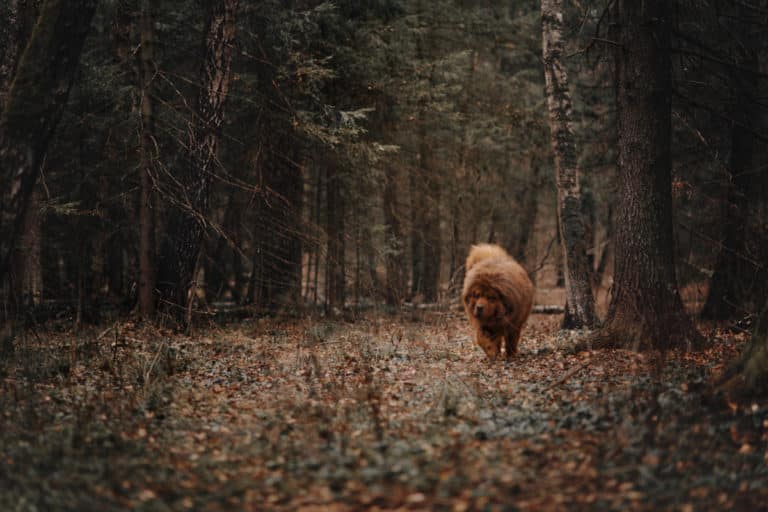One of the first things you’ll notice about a Tibetan Mastiff is size. Compared to smaller breeds, they need more space to move around. They can live indoors or outdoors.
The two settings have their fair share of pros and cons. Staying indoors can cause problems when a Tibetan Mastiff didn’t go through house training. An outdoor setup with the absence of training makes him prone to nuisance barking.
Do Tibetan Mastiffs Need a Lot of Space?
Because of their size, a small, confining space is not advisable for Tibetan Mastiffs. A decent amount of space is needed for them to comfortably move around. Having a yard is a good thing for training and exercise.
If you have a fence, it should be sturdy and 5 to 6 feet high (1.5 to 1.8 meters) at the very least. This is to prevent them from escaping and let them know of boundaries. They are very territorial and a fence establishes a limit to their territory. This is also a way of protecting innocent passersby from attacks.
Another risk to consider in a jam-packed neighborhood is excessive barking. That is why the bigger the space is the better.
Are Tibetan Mastiffs Good House Dogs?
They’re excellent guards and companions for your family. Tibetan Mastiffs are good house dogs but not for first-time owners. You need to train them first since they’re a bit strong-willed without guidance.
They can also be aggressive and destructive when bored and provoked. You need to familiarize him with the dynamics in your household. Like teaching little kids, you have to establish rules and limitations.
As the leader of the pack, it’s your responsibility to keep his violent side at bay. It’s a great idea to get help from a trainer. If the training went well, a Tibetan Mastiff is going to be a good friend and protector.
Are Tibetan Mastiffs Good for Apartments?
A big dog and a small space are not an ideal combination. Tibetan Mastiffs are big and making them stay in an apartment is not advisable. The small space can restrict their movements.
They can bump into things and anxiety might set in because of this. Being confined in a small space is an uncomfortable feeling. The proximity between other households is a possible cause for other issues.
Keeping his nighttime barking under control can be difficult if he’s untrained. The neighbors might have a problem with this during bedtime. If you’re planning to keep a Tibetan Mastiff at home, a bigger space is recommended.
Keeping an untrained Tibetan Mastiff in an apartment can be difficult. This breed is not a good match for first-time owners. If you are one, it’s better to start with a different breed.
Are Tibetan Mastiffs Easy to House Train?
Tibetan Mastiffs are intelligent dogs and are easy to house train if you play your cards right. But the intelligence that they possess is like a double-edged sword. They tend to be stubborn when they don’t feel like following orders.
That is why they’re not recommended for new owners. Traditional and strict training can give you unsatisfactory results. You need patience, consistency, and some assistance from a trainer.
Earning a Tibetan Mastiff’s respect is like a badge of honor you can be proud of. You have to establish that you are a pack leader before he starts listening to you. When you finally got there, house training would be easier and smoother.
It’s also better to start training him at a young age. Most people would say that you can’t teach an old dog new tricks. Though it’s a little more challenging, it’s possible and the payoff is worth the effort.
How Long Does It Take to House Train a Tibetan Mastiff?
The standard period for house training is 4 to 6 months. The length will depend on a dog’s size. Smaller dogs can take a year before they catch the training’s drift.
Since Tibetan Mastiffs belong to larger breeds, 4 to 6 months of house training would be enough. Don’t forget to assign yourself as the pack leader before he starts listening to you. You might need a combination of assertive and friendly approaches.
Being too forceful can make him anxious or even angry at you. Being too cuddly on the other hand can make you look weak in his eyes. Keep everything in balance for successful results.
Experts say that they’re more primitive and too much of a dog. So a slightly different approach is needed. Be patient and consistent with training to claim the spot of a pack leader.
How Do You Housebreak an Adult Tibetan Mastiff?
The length of housebreaking will depend on an adult dog’s experience. It may take a week or two if your dog is already familiar with potty break routines. A Tibetan Mastiff without prior training may take longer to housebreak.
It would take several weeks for him to adjust and get used to your household. You need to provide a comfortable space indoors and outdoors. Tibetan Mastiffs are smart so they will eventually get the hang of it.
But because of their independence, they may try to assert how they want things to be. This is where your patience and commitment will be tested. Follow a schedule and let him know that you’re the leader of that household without the iron fist.
Some help from a trainer is also a great idea. Training an adult dog is more challenging but not impossible. It is preferred that you start training a dog while he’s young.
Most adult dogs are pretty much set on their ways, you can’t just give up though. Keep everything in balance to achieve the desired results. Don’t rule with an iron fist but don’t be too friendly either.
Can Tibetan Mastiffs Be Kept Outside?
Although Tibetan Mastiffs are resilient dogs, it’s not recommended to leave them outside. A couple of hours is good for exercise and playtime. But they’re better off relaxing indoors with your family.
It’s possible to leave them outdoors from time to time. The issue is that they can get anxious and bored when you’re not around. So don’t leave your Tibetan Mastiff for too long.
Boredom can trigger aggressive behavior, barking, and digging. Tibetan Mastiffs are known for being independent and their bodies can tolerate the elements. But your absence will somehow bother him.
Despite not being overly affectionate, this breed loves the company of its owner. It’s alright to spend some time outdoors once in a while. If you’re planning to keep him outside, he’ll need some training and other necessary resources.
Temperature is also a thing to consider. When it’s too hot or too cold outside, let him in to avoid risking his health. Some days are better spent indoors for safety.
How Do You Keep a Tibetan Mastiff Outside?
Keeping your Tibetan Mastiff outdoors is not always encouraged especially if he’s untrained. But if you have decided to go on with it, you’ll need to take care of a few things. Your yard has to be big enough for him to move around.
He might get anxious and frustrated if he’s stuck in a confining space. A fence should be strong and high enough to let him know about boundaries. You can also provide him with a doghouse where he can sleep comfortably.
Adding a litter box nearby is also great for potty breaks. It should be far enough from his food/water bowl to avoid contamination. Give him occasional trips outside his fence for fun activities.
Before accomplishing all these things, train him patiently. Training a Tibetan Mastiff to stay outside is challenging if he’s already comfortable staying indoors. While he’s young, you have to make up your mind about what kind of setup you prefer.
In general, staying indoors is still the better option. Mix that with proper house training and you’ll have an awesome time together. Tibetan Mastiffs enjoy minding their own business but they don’t like the idea of an absent owner.








